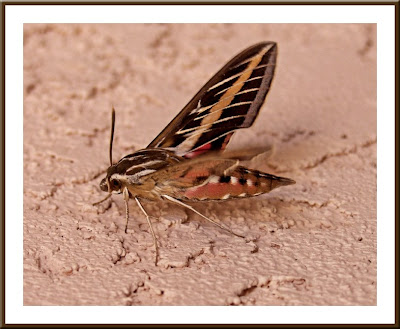


 It is said that the white-lined Sphinx Moth that I found at my doorstep this morning is common to the Southwestern United States, but I couldn’t readjust my thinking to consider it ordinary. After I took my pictures, I went on-line to see what I could learn about it. I found that it is one of the largest flying insects in the desert. Although mine has a wingspan of only three inches, they can sometimes exceed five inches. Apparently it gets it’s name from the way it rears up, sphinx-like, when alarmed while it is still in the larvae stage. These moths are often mistaken for hummingbirds because of the way they hove when feeding.
It is said that the white-lined Sphinx Moth that I found at my doorstep this morning is common to the Southwestern United States, but I couldn’t readjust my thinking to consider it ordinary. After I took my pictures, I went on-line to see what I could learn about it. I found that it is one of the largest flying insects in the desert. Although mine has a wingspan of only three inches, they can sometimes exceed five inches. Apparently it gets it’s name from the way it rears up, sphinx-like, when alarmed while it is still in the larvae stage. These moths are often mistaken for hummingbirds because of the way they hove when feeding. Sphinx moths change underground into adult moths, and then they dig their way to the surface. They get right to the important task of mating shortly after getting to the surface. The females lay as many as 1,000 eggs on the underside of plants that serve as food for hatchling grubs. Eggs hatch within a few days. Life is short for these creatures... which is a reminder that everything is relative. Males and females die after they have completed their roles in the reproductive process.
No comments:
Post a Comment